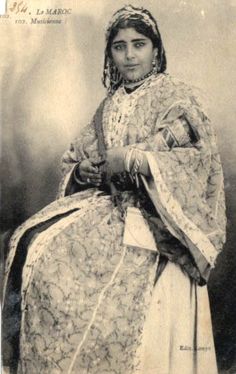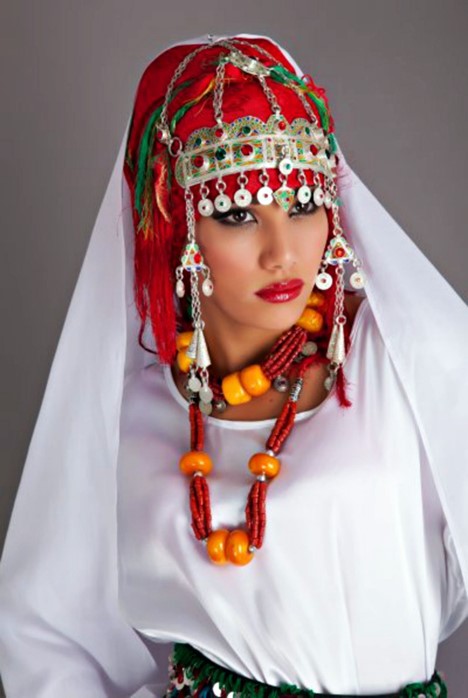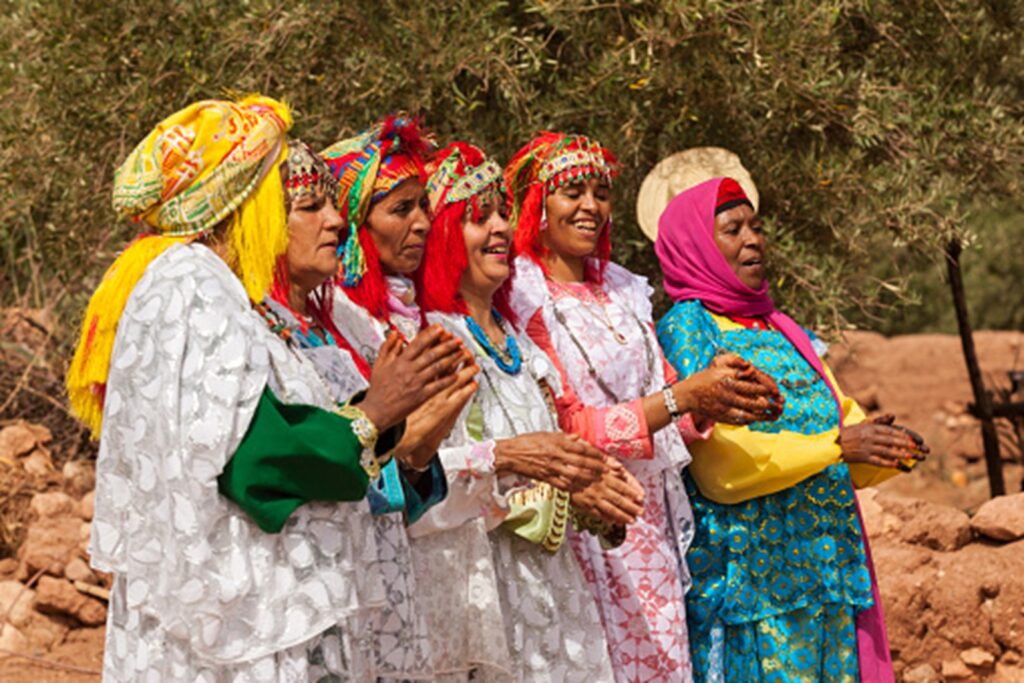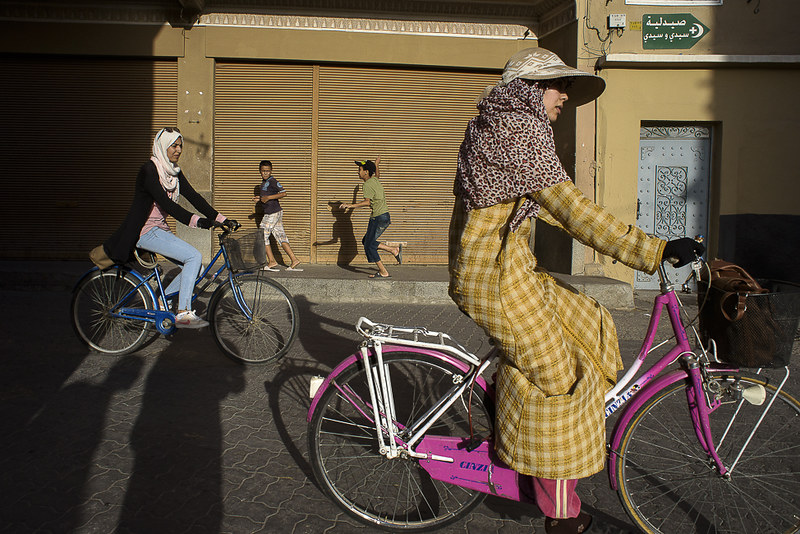Article author: Dr Mohamed Chtatou
Date of publication of the article: 30/06/2022
Year of publication: 2022
Article theme: Ethnography, History, Marruecos, Morocco, Mujer, Music, Women.
The complex landscape of language politics of Tamazight and Literary Arabic, influenced by French colonialism, has resulted in the Moroccan government’s deliberate rejection of the responsibility of cultural preservation, leaving the task to the Amazigh society. As the Imazighen themselves must sustain their language and culture in the face of underrepresentation in the public sphere, this article argues that the gendered nature of Tamazight has placed women in a unique position to carry on the traditions of their community. Rural women—especially those who are illiterate— preserve Tamazight as a living and vibrant language, infusing traditional art forms with orality to pass on language traditions from generation to generation. In the genre of music and poetry, Amazigh women use their verses to keep the community informed of the movements of disparate members. They narrate and record important community events for oral history, enforce moral and social codes, and remind the extended community of their common bonds.
Historical Context, the impact of the colonial period
 Fatima Sadiqi points out that the Amazigh language has survived until modern times despite remarkable conditions hostile to its preservation (Sadiqi 2013, 110). Tamazight has had to compete with multiple other languages which have had relatively more political power, such as French and Arabic. Only since 2011 has it been an official language in a centralized state. In fact, in recent history, Amazigh society and the Tamazight language were sidelined by the government in an attempt to bolster postcolonial Arabization. The French colonial government adopted a “divide and rule” strategy that promoted Berber culture through a number of policies that also deemphasized Arab and Islamic identity. The French gave the Amazigh the option to use customary law instead of sharia law, and established Berber schools which excluded the use of Arabic in instruction. These policies were an attempt to bring the Berbers under the umbrella of French culture and increase distance, and possible enmity, between the Berbers and the Arabs, thereby strengthening the colonial system by weakening societal ties.
Fatima Sadiqi points out that the Amazigh language has survived until modern times despite remarkable conditions hostile to its preservation (Sadiqi 2013, 110). Tamazight has had to compete with multiple other languages which have had relatively more political power, such as French and Arabic. Only since 2011 has it been an official language in a centralized state. In fact, in recent history, Amazigh society and the Tamazight language were sidelined by the government in an attempt to bolster postcolonial Arabization. The French colonial government adopted a “divide and rule” strategy that promoted Berber culture through a number of policies that also deemphasized Arab and Islamic identity. The French gave the Amazigh the option to use customary law instead of sharia law, and established Berber schools which excluded the use of Arabic in instruction. These policies were an attempt to bring the Berbers under the umbrella of French culture and increase distance, and possible enmity, between the Berbers and the Arabs, thereby strengthening the colonial system by weakening societal ties.
But this strategy had lasting implications for Amazigh society in the post-colonial period, as the new government hastened to emphasize Arab and Islamic identity—a mission manifested in policies that can be considered at best a pushing aside of Amazigh issues and at worst outright discrimination. Tamazight did not receive official recognition until 2011, Moroccan televisions did not broadcast in Tamazight until the 1990s, and until recently some Amazigh names were illegal to use. With the Moroccan government’s demonstrated disinterest in Amazigh issues, the responsibility for the survival of Tamazight was pushed to the periphery, to the Imazighen themselves. Within Amazigh society, it can be seen that women—in particular rural and/or illiterate women —play a vital role in preserving Tamazight in the absence of adequate representation in the public sphere. There are a number of reasons why women are now the primary caretakers of Amazigh language and culture.
Amazigh Women’s Relationship with Language
 First, the Arabic and Tamazight languages have gendered connotations in their environments of usage, as Literary Arabic is associated primarily with men and Tamazight with women (Sadiqi 2007, 27). The primary environment of Modern Standard Arabic is official and professional: political offices, business agencies, religious institutions, legal offices, and the media all utilize Literary Arabic. It is the default language of written knowledge (Sadiqi 2007, 27). Despite recent reforms, there is a conspicuous absence of Tamazight from such official arenas. And because Literary Arabic is the language of the public sphere, its most proficient and prolific speakers are men—far better represented in the public sphere than women. Tamazight, on the other hand, has only recently started to be taught in schools and used in an official governmental capacity, and is often not written at all. Its primary environment is the home—the private sphere—and is commonly used to disseminate oral literature, folk stories, and traditions. Its use is intimate and informal. Even in the numbers, the gendered nature of the languages is evident (Sadiqi 2003, 6). These characteristics inform the gendered nature of the language. As Fatima Sadiqi says, the situational context of Tamazight has lent the language a distinctly feminine connotation:
First, the Arabic and Tamazight languages have gendered connotations in their environments of usage, as Literary Arabic is associated primarily with men and Tamazight with women (Sadiqi 2007, 27). The primary environment of Modern Standard Arabic is official and professional: political offices, business agencies, religious institutions, legal offices, and the media all utilize Literary Arabic. It is the default language of written knowledge (Sadiqi 2007, 27). Despite recent reforms, there is a conspicuous absence of Tamazight from such official arenas. And because Literary Arabic is the language of the public sphere, its most proficient and prolific speakers are men—far better represented in the public sphere than women. Tamazight, on the other hand, has only recently started to be taught in schools and used in an official governmental capacity, and is often not written at all. Its primary environment is the home—the private sphere—and is commonly used to disseminate oral literature, folk stories, and traditions. Its use is intimate and informal. Even in the numbers, the gendered nature of the languages is evident (Sadiqi 2003, 6). These characteristics inform the gendered nature of the language. As Fatima Sadiqi says, the situational context of Tamazight has lent the language a distinctly feminine connotation:
“As a language of cultural identity, home, the family, village affiliation, intimacy, traditions, orality, and nostalgia to a remote past, Berber perpetuates attributes that are considered female in the Moroccan culture.” (Sadiqi, 2013).
Further underscoring the gendered nature of language politics, the task of preserving language and culture for society is gendered in itself: while urban men are primarily responsible for the campaign to bring Tamazight to the forefront of public consciousness, rural women are the ones who preserve and keep alive the language within their own communities (Hoffman 2006, 147). The orality of illiterate women is a major factor in Tamazight’s survival, as they use the language in household communication, raising children, and repeating folk stories, poems, proverbs, songs, and family and cultural histories. Because the mother tongue, Tamazight and related Amazigh languages, is not the language of instruction in formal schooling, it falls to Amazigh women to transmit knowledge of the mother tongue to subsequent generations (Ennaji, 168). And as the primary caregivers of children, women are children’s first link with Tamazight—lending the language its status as a mother tongue (Sadiqi 2007, 31) and further cementing its longevity despite lacking representation in the public sphere.
Another reason why women can be considered to be the primary actors in preserving Tamazight is found in their related role as guardians of culture. In addition to managing their households and raising their children, women are vital in sustaining Amazigh artistic and cultural heritage through their work in mediums such as textiles, music, poetry and dance (Becker 2013, 120). Again, illiterate women are particularly important as they infuse these arts with oral traditions transmitted from generation to generation. For example, women give Tamazight names to patterns and motifs in their textiles and pass them on to their daughters (Becker 2013, 131). The names vary according to the similarity the weaver imagines between the pattern and surrounding objects or the natural world (Becker 2013, 131) such that a single pattern may have a multitude of descriptive Tamazight names for different artists and families. Song and dance have similar oral traditions: specific movements also have descriptive Tamazight names according to the actions they invoke, and song lyrics are never written down but instead transmitted orally over generations (Becker 2006, 49).
Oral Traditions: Women in Song and Music
Katherine Hoffman’s research about Amazigh women’s participation in song and music illustrates how their maintenance of cultural traditions serves a greater purpose than preservation of language. In fact, they constitute the very glue of society in a time when many Amazigh families are geographically separated.
Families in this community have been estranged, as the womenfolk are left behind when fathers and husbands migrate far from home in search of work. The responsibility of maintaining social order at home—sustaining peaceful relations with neighbouring groups, keeping apprised of the movement of people and goods in their area—falls to the women left behind (Hoffman 2002, 513). Their watchfulness in ensuring social and economic security for their communities are constantly narrated through lively tizrrarin. Tizrrarin, a capella couplets, are an important part of Amazigh women’s oral traditions. They are performed without musical or percussive accompaniment and often invite audience participation through repetitive call-and-response lines (Hoffman 2002, 513). The tizrrarin performed by many Amazigh women, such as those in the situation described above, exhibit a number of remarkable phenomena.
First the lyrics are not simply for entertainment, but for news of family members’ migration and travels, and upcoming social events such as weddings or festivals. So even as they sing them, Amazigh women’s tizrrarin serve to link disparate members of their community, maintaining a sense of unity even despite the challenges of geographic separation. The verses’ particular significance to their local communities is illustrated by the fact that this genre has never been commercialized for wider consumption, as many others have in music festivals and tourist hotels (Hoffman 2002, 514).
The second function of tizrrarin is to narrate and record for oral history events that bring the community together. Just as these verses are often sung to herald the arrival of the wedding parties at local weddings, they are also sung at the celebrations themselves. Tizrrarin are heard on every day of the multi-day celebrations and serve to stitch together in the community’s collective memory the important hallmarks of such events. In Katherine Hoffman’s observation, they “[mark] liminal movements by filling gaps between what people consider events: waiting to be served meals, riding atop a pickup truck from the bride’s village to the groom’s village, or welcoming guests into a village” (Hoffman 2002, 514).
The third important impact of tizrrarin on the strength of Amazigh communities is its role in forging bonds and bridging gaps across differences, thus mediating potential conflict. Again, this function, like the others, illustrates the particular use of women’s oral and language traditions in sustaining Amazigh communities. Public gatherings, such as weddings, can grow to immense proportions in Amazigh culture; wedding guests, for example, may number up to five thousand (Hoffman 2002, 517). Such events are opportunities for diverse family groups and tribes to come together, with guests traveling significant distances to attend the event. As such, past or current conflicts and differing opinions bring the potential for discord in such large gatherings. One role of the tizrrarin is to declare bonds between people by “articulating collectively held moral and social norms” (Hoffman 2002, 517), thus nipping conflict in the bud before it even begins by reminding people of their commonalities and creating a sense of communal and familial unity. In general, the responsibility of enforcing moral codes in Amazigh communities falls to older, married women. They encourage unity in times of conflict by mediating disputes between factions (Hoffman 2002, 519). Their sung verses serve much the same purpose, with lyrics speaking of the mutually-beneficial security found when villages and social groups work and live together in peace. Katherine Hoffman translates a song to illustrate this theme:
“We are one, me and you (plural)
We share walls
Our fields share boundaries and springs
As one they are irrigated
From our channels we water yours. ” (Hoffman 2002, 517).
Cultural Production: Women in Material Arts
Amazigh women also have a role in cultural production in their societies—yet another way in which they serve as primary figures in the preservation of Amazigh culture and traditional life even today. Their work in the material arts is so rich and prolific that Cynthia Becker, a scholar of African arts specializing in Amazigh culture, says unequivocally that “Berber women are artists” (Becker 2006, 42). Their artwork not only reflects themes of Amazigh identity, but of femininity and motherhood—a reminder of women’s high status in that society.
Amazigh women often weave carpets during pregnancy, using figures and motifs that symbolize life, fertility, and the child in the mother’s womb. Becker has even observed the personification of Amazigh textiles on the loom to symbolize women’s essential role in the giving of life and preservation of Amazigh identity:
“In some areas of Morocco, weavers physically straddle the warp threads and beams of the loom before they are raised, symbolizing the birth of the textile. The textile then moves through youth, maturity, and old age as it is woven.2 Women have the power of life over a textile, and when a weaver finishes it, she cuts it from the loom and the textile is said to die. This personification of the textile underlines women’s reproductive and creative powers and, by equating textiles with humans passing through the life cycle, reinforces women’s roles in the propagation of Amazigh identity. “(Becker 2006, 44).
Looking to the Future
According to Fatima Sadiqi, Amazigh languages owe their survival first and foremost to women (Sadiqi 2007, 27). While such a statement may shock some at first, a careful look at the multitude of ways in which Amazigh women sustain their linguistic and cultural heritage sheds light on just how important women are in the protection and production of culture. The case of Amazigh languages is itself a testament to their work: these languages are ancient, and yet have only very recently become the official language of a centralized state—the efficacy of which policy is even debatable—and have long had to compete with other languages having relatively more social power, like Punic and Latin in the past or Arabic and French today (Sadiqi 2007, 27).
The Moroccan government has recently enacted policies to promote Amazigh culture and language, such as installing Tamazight as an official language and introducing its instruction into Moroccan schools. While the methods involved in these efforts have admittedly been the object of much debate and criticism, and though the political motives which are potentially entangled in such efforts are not the subject of this paper, the basic fact remains: the use of Amazigh languages is strongly associated with women, and any efforts at promoting them will certainly have an effect on the advancement of Amazigh women. Indeed, education is an essential tool in the elevation of women’s status in all areas of development.
While rural women from traditional communities must be given the most credit for preserving their linguistic and cultural heritage, so they will be the ones to benefit the most from language-teaching today and in the future. As it stands, the language barrier between Tamazight-speaking women in the periphery and Arabic-speaking professionals in the center is one that bars these women access from the most basic functions of society and centralized government. For a relevant example one need only imagine the difficulty a Tamazight-speaking woman might have interacting with, and communicating her needs to, an Arabic-speaking doctor or law enforcement official. But educational practices inclusive of Amazigh languages can do much for the promotion of women, and the teaching of a language which serves as the sole or mother tongue of so many women may very well herald the inclusion of more women in the public sphere. Feminist scholars such as Fatima Sadiqi see much to be hopeful about in Morocco’s future. As she states,
“The active participation of women in public affairs may enable the languages to be used equitably. Such participation could even change usage and attitudes towards the languages: it could demystify and reduce the gap between men and women as well as between the languages in use. “(Sadiqi, 28).
Language as a means of empowerment
It is important to note, however, that, just as the task of cultural preservation has fallen to Amazigh women, a similar observation can be made about women’s empowerment. Just as Amazigh women are active producers of linguistic and cultural traditions, so they are active seekers of their own empowerment. Where the structures of government and society may have been failing to elevate the status of women and secure for them a measure of social power, Amazigh women are nevertheless negotiators of power in language politics. From all socioeconomic backgrounds, they use language and oral traditions to shape their communities, preserve traditions, and achieve personal gains in daily language use (Sadiqi 2003, 1). As described previously, the vastly different environments of usage for Morocco’s languages have lent its major language gendered reputations, and such separation has an inherent equality— particularly when considering the challenge of limited access to public or professional services, as mentioned above. But even so, Amazigh women are not passive objects when it comes to language politics, but rather active participants.
Despite the fact that Amazigh women have to contend with a heavily patriarchal society, they use the linguistic choices available to them according to their socioeconomic position in order to develop empowering strategies of communication (Sadiqi 2003, 12). A number of the oral traditions already discussed in this paper may be analyzed to discover the subtle multitude of ways in which Amazigh women negotiate social power for themselves.
Rural and/or illiterate women accomplish this through their proficiency in oral literature and traditional skills passed down orally through the generations. In regards to the first, the nature of Morocco’s patriarchal society has largely silenced oral female genres, and Sadiqi characterizes the nature of Moroccan women’s contribution to oral literature as “‘unofficial’ voices that circulate as ‘anonymous’ literature in the community without being officially recognized” (Sadiqi 2003, 13). However, this has a surprising empowering effect for these women because, having never gained social authority, their voices are less subject to social constrains and have more room for self-expression (Sadiqi 2003, 13). Rural and/or illiterate women also use orality to negotiate social power through their knowledge of traditional skills. Skills like midwifery, childbearing, child-rearing, herbal remedies, carpet weaving, henna art, and cooking are all mastered and passed down through the generations by women (Sadiqi 2003, 13). Though they are not necessarily prominent or prestigious skills, they are necessary for the survival of the society and women maximize their value by keeping a measure of secrecy surrounding the mastery of these skills. As Sadiqi explains, “the acquisition of traditional skills is an opportunity for girls and women to experience typically female sensations that give women authority in all-women gatherings and ‘hidden’ power in society at large” (Sadiqi 2003, 14).
Storytelling is another way in which Amazigh women assert themselves and prove their social value, especially for older women who may feel their status being usurped by younger women who are able to bear children (Sadiqi 2003, 17). Grandmothers will entertain their audience, often younger children, through suspenseful unfinished stories. Their skilful weaving of stories is highly respected, and not just as figures for entertainment; “they exhibit powerful thinking, memory and skilful use of psychological knowledge of human nature” (Sadiqi 2003, 17). Their stories may even contain themes that subtly reference and challenge their patriarchal society, with female protagonists who use their intelligence to triumph over their male counterparts (Sadiqi 2003, 17).
Conclusion
This article has briefly discussed the historical and political context of language politics in Morocco as it relates to Tamazight, as a background to understand the gendered nature of the language, especially as when compared to Literary Arabic. French colonial policies had lasting implications for Amazigh society in the post-colonial period, as the new government hastened to emphasize Arab and Islamic identity. The unfortunate result was a severe delay in official recognition of Amazigh interests, and policies that failed to understand the importance of Amazigh identity and culture in Morocco. Given the Moroccan government’s demonstrated disinterest in Amazigh issues, Amazigh women—in particular rural and/or illiterate women—play a vital role in preserving their traditional language and culture in the absence of adequate representation in the public sphere. Although these complicated language politics lend both Arabic and Tamazight distinctly gendered natures, and represent an inherent inequality between the sexes, it also gives women a uniquely empowering role as caretakers and transmitters of Amazigh language and culture. Women’s role in house and home lends them a natural inclination to language, for example in their teaching of language to their children, but are also active participants in other oral and cultural traditions: song, dance, folk stories, and material arts. Even when faced with systemic gender inequalities and a lack of government support in preserving Amazigh culture, Amazigh women have been seen to be active negotiators of social power in their use of language. Far from the role of passive objects so often ascribed to them by outsiders, their use of language is creative and powerful, securing for themselves the social empowerment neglected by others.
Dr. Mohamed Chtatou
References
Adams, Shaina; Brahim El Guabli. “Resisting Persecution and Maintaining Cultural Roots: The Amazigh People of Morocco.” Fellowship 73.7-9. (2007): 21-23. Web.
Becker, Cynthia. Amazigh Arts in Morocco: Women Shaping Berber Identity. 1st ed. Austin: University of Texas, 2006. Print.
Becker, Cynthia. “Amazigh Textiles and Dress in Morocco.” African Arts 39.3 (2006): 42-55. Web.
Hoffman, Katherine E. “Berber Language Ideologies, Maintenance, and
Contraction: Gendered Variation in the Indigenous Margins of Morocco.” Language
& Communications 26 (2006): 144-67. Web.
Hoffman, Katherine E. “Generational Change in Berber Women’s Song of the Anti-Atlas Mountains, Morocco.” Ethnomusicology 46.3. (2002): 510-540. Web.
Sadiqi, Fatima. “Berber Women’s Oral Knowledge.” Women and Knowledge in the Mediterranean (2013) New York: Routledge, NY. 108-43. Print.
Sadiqi, Fatima. “The Role of Moroccan Women in Preserving Amazigh Language and Culture.” Museum International 59.4 (2007): n. pag. Web.
Sadiqi, Fatima. “Women and Linguistic Space.” Women and Language 29.1 (2003): 35-43. Web.
Yacine, Tassadit. “Women, Their Space and Creativity in Berber Society.” Race, Gender & Class 8.3. (2001) : 102-113. Web.




